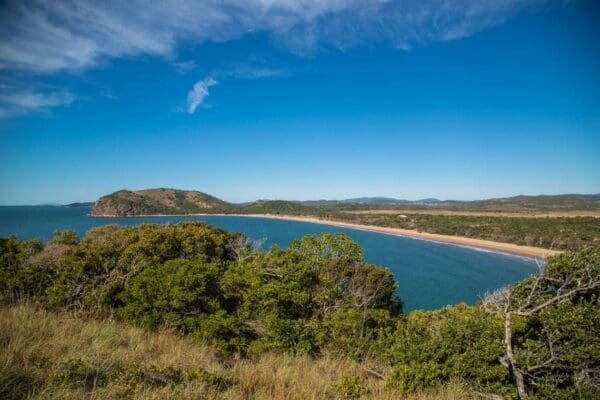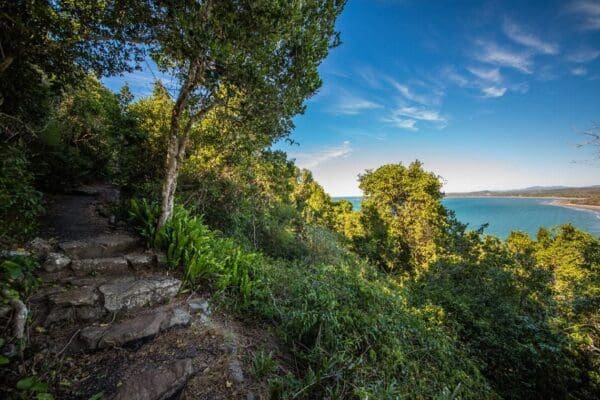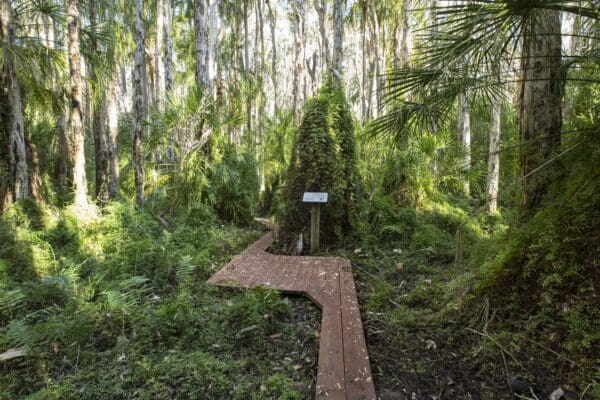Hike at a Glance
Max elevation: 78m
Min elevation: 12m
Total Ascent: 80m
Hike overview
The Little Five Rocks Beach Track is a 1.2km, grade 3 hike that takes you through a striking section of Byfield Conservation Park, Queensland. This short walk typically takes around 45 minutes to complete, offering an ideal opportunity to immerse yourself in the area's coastal beauty. Byfield’s national and conservation parks are home to some of the most breathtaking scenery, with vast stretches of coastal heath, towering eucalypt woodlands, and lush rainforests where water is plentiful. The parks are also a haven for both migratory and resident birds, making it a great spot for wildlife enthusiasts.
The trail begins by passing through the tranquil Findlays Creek wetland, where you’ll be surrounded by the refreshing scent of pandanus trees. From here, you’ll follow a gently stepped track that winds its way towards the untouched Little Five Rocks Beach. This vehicle-free beach is a peaceful retreat, offering sweeping views of the coast without the crowds. As you walk, you’ll feel a deep connection to the landscape, with every step drawing you deeper into the natural beauty of Byfield. Whether you’re enjoying the quiet solitude or taking in the diverse plant and animal life, this track offers a rewarding experience for those looking to connect with the wild side of Queensland.
Track grade
Grade 3 (Moderate) - Walks for Most Fitness Levels: Grade 3 on the AWTGS represents moderate walking tracks. These are ideal for walkers with some fitness who are comfortable with some hills and uneven terrain. While suitable for most ages, some bushwalking experience is recommended to ensure a safe and enjoyable experience. Tracks may have short, steep hill sections, a rough surface, and many steps. The total distance of a Grade 3 walk can be up to 20 kilometers.
Walk map and GPX file
Max elevation: 78 m
Min elevation: 12 m
Total climbing: 80 m
Total descent: -80 m
Content use
Please don’t copy GPX files or content from this site to AllTrails or other platforms. Each trail has been personally mapped, documented, and refined to support Australia’s bushwalking and hiking community. While some details come from land managers, every listing reflects significant personal effort. This is a free, community-driven initiative—your respect helps keep it that way.
Gallery
Got any photos from this hike? Your photos can help others plan. Share shots from along the trail so fellow hikers know what to expect.
Click to add your photos >>
Getting there
Getting to the trailhead: Byfield Conservation Park.
Reaching the trailhead for Little Five Rocks Beach requires a 4WD with high clearance and solid experience in sand driving, as the tracks through Byfield National Park can be demanding. From Byfield, the route takes you approximately 35 kilometres through a mix of firm gravel roads and deep sand tracks, including the notorious “Big Sandy” dune, which can be a challenge even for seasoned drivers.
Start by heading south-east on Byfield Road, then turn left onto Waterpark Road. Continue onto Sandy Creek Road before taking a slight left onto Stockyard Road, which leads to the park entrance. From here, follow the signs to Five Rocks camping area, where you’ll find access to the walking track leading down to Little Five Rocks Beach. The final stretch is on foot, taking you through coastal heath and pandanus-lined pathways before reaching the secluded, vehicle-free shoreline.
Before setting out, check current track conditions, as sand depths can change with the weather. Be well-prepared with recovery gear, extra fuel, and plenty of water, as assistance in this remote area can be limited. Planning ahead will ensure a safer and more enjoyable experience in this stunning part of Byfield.
Need a rental car to get you to the hike? Find one here.
About the region
Byfield National Park, Byfield Conservation Park, and Byfield State Forest offer diverse landscapes, from rugged coastal dunes to lush rainforest creeks. Located about 70 kilometres north-east of Rockhampton, these parks provide a perfect escape for nature lovers, whether you're hiking, camping, or simply enjoying the scenery. Towering sand dunes, striking pinnacles, and tranquil waterways make this region a haven for outdoor adventure.
Covering over 15,000 hectares, Byfield National Park is known for its vast coastal heathlands and impressive parabolic dunes, some stretching 5–6 kilometres inland. The northern section features the rugged peaks of Mount Atherton, while sheltered areas support tall eucalypt woodlands and lush rainforest. The park is also a prime spot for birdwatching, with a mix of migratory and resident species.
Byfield Conservation Park offers more coastal beauty, while Byfield State Forest combines native forest with exotic pine plantations. The forested ranges and Water Park Creek provide excellent opportunities for camping, picnicking, and bushwalking. Boating, fishing, and 4WD adventures are also popular in certain areas. However, road conditions can change rapidly, with flash floods sometimes making access difficult, so visitors should check weather forecasts before heading out.
Just an hour from North Rockhampton or 30 minutes from Yeppoon, Byfield is ideal for outdoor enthusiasts of all levels. Whether you're looking for an easy walk or a more challenging hike, Trail Hiking Australia has the best trails to help you explore this remarkable region.
Find a place to stay
Wondering where to stay near this hike? Find accommodation close to the trailhead — hotels, cabins and campgrounds nearby. Click the button to view the interactive map.
Closest towns to this walk: Barmaryee, Inverness, Meikleville Hill, Taranganba, Yeppoon
Let someone know
Heading out? Fill in a trip intentions form so someone knows your plans. If things go wrong, they can raise the alarm fast, giving you peace of mind on the trail.
Similar walks nearby
Looking for more walks in or near Byfield Conservation Park? Try these trails with a similar difficulty grade.
Suggest an edit
Notice something different about this trail? Whether it’s a new feature, a route change, or a closure, share your update so we can keep our info accurate and helpful for fellow hikers.
Click to suggest edits >>
Explore safe
Plan ahead and hike safely! Carry enough water, pack layers for changing conditions, and bring safety gear like a torch, PLB, and reliable communication device. Check official sources for trail updates, closures, and access requirements, and review local weather and bushfire advice. Most importantly, share your plans with someone before you go. Being prepared makes for a safer and more enjoyable hike! Stay Safe, Explore More, and Always #ExploreSafe.
Packing checklists
What you carry in your pack depends on factors like weather, terrain, and your adventure type. Not sure what to bring? My free planning, food, and packing checklists are a great starting point, covering day hikes, overnight trips, and multi-day adventures. Use them to customise your kit and always prioritise safety.
Acknowledgement of Country
Trail Hiking Australia acknowledges the Traditional Owners of the lands on which we hike and pay respects to their Elders, past and present, and we acknowledge the First Nations people of other communities who may be here today.






